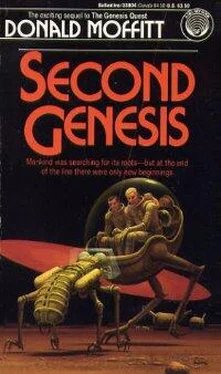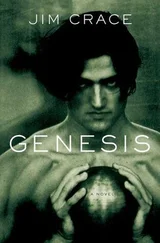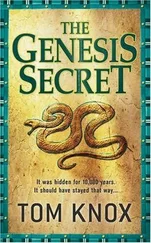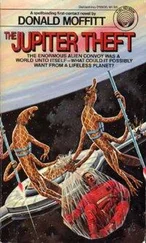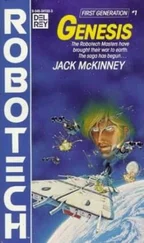“Jupiter stripped down to its rocky core,” Bram said in a flash of insight. “But more important, with that terrible pressure released, the shell of metallic hydrogen surrounding the core could’ve changed state and boiled off. Which would have removed Jupiter’s magnetic field. And with it, the deadly radiation belt that Jovians have.”
Jun Davd nodded approvingly at his former pupil. “Which would have made the moons of Jupiter habitable.”
“Five new worlds,” the stocky playwright, Dal, said. “The four large moons plus Jupiter itself. All the real estate Original Man could have used. Seven, counting Mars and Venus. That bears me out. Original Man was not responsible for that stinking stew down there!”
He gestured vehemently at the observation window, where the blotched brown world floated against the cleanliness of space.
“No, they have abused their legacy most grieviously,” murmured Jun Davd. “Original Man once had a ring city and linked synchronous satellites draped around the waist of his lovely world, did you know that?”
There were oohs and ahs from the visitors. While Jun Davd explained, Bram turned his attention to the most interesting of the holographic displays that had been set up around the observatory—the one produced by gravitational imaging. It showed a tangled belt of overgrown wreckage around the equator of the slowly revolving planet, The buried debris must have been millions of years old. It made ridges in the sea floor, a single straight line of low hills across the land. The devastation when it crashed must have been inconceivable. Perhaps it had been the planetary disaster that had cleared an evolutionary path for the ascent of the rat-people.
Hogard was still insistent. “Okay, there are five rocky worlds doing a complicated dance around one another where Jupiter ought to be. But what about the other three gas giants this system is supposed to have? Did Original Man strip them, too?”
“No!” Mim cried with sudden heat. “I’ve seen the pictures of Saturn’s rings! Human beings never would have done that to her!”
Bram followed her gaze to the long gallery wall of planetary images that Jun Davd had put on display. It was a selection made from the hundreds that had been taken while Yggdrasil plunged through the Sol system. The one that upset Mim showed a grim, yellow-stained ball of rock where a scummy ocean lapped at a tarnished shore. Yggdrasil had passed within a million miles of it. Even at that distance one could distinguish the scab of habitation that covered much of the land surface.
“I agree, Mim,” Jun Davd said. “Perhaps the rat-people did that. Saturn was the next world out. They may not have had our sense of aesthetics.”
“Atmospheric mining is simple in principle,” Bram said. “A satellite in low orbit with a couple of hundred miles of siphon suspended beneath it. The vacuum of space operates the siphon. The orbit has to be readjusted every once in a while to compensate for atmospheric drag on the hose, but there’s plenty of reaction mass available to do it with. The rat-people could have mined their hydrogen that way and had another planet available after Saturn was sucked dry.”
“Eight planets,” Jun Davd said. “Of Saturn’s satellites, seven are more than three hundred miles in diameter—including one moon as big as Mercury—and the dragonflies are using them all.”
“That wasn’t enough for them,” Bram said grimly. “We’ve detected dragonfly broadcasts from the leftover cores of what must have been Uranus and Neptune—and all of their moons that we were able to get any separation on.”
“They’re breeders!” Dal blazed. “Any piece of rock big enough for them to light on!”
“Yes, indeed,” Jun Davd agreed. “Our resident sociobiologist, Heln Dunl-mak, tells me that she estimates the total dragonfly population of Sol system to be more than ten trillion.”
The figure was mind-boggling—too big to grasp. Bram heard the gasps around him.
“And they’re pushing outward,” Jun Davd went on. “If the diskworld system of Delta Pavonis represents their present limit of expansion, then they now occupy a volume of space forty light-years in diameter.”
He was about to go on, when an alarm went off. He picked up an interphone and listened briefly. He reached out and switched on a display. “Yes, yes, I see them now,” he said.
He put down the interphone set and faced the circle of suddenly quiet people. “That was Smeth,” he said. “Our sensors have detected the firing of launch vehicles. It appears that the dragonflies have decided that Yggdrasil is a likely-looking piece of real estate.”
Bram watched through the scope as a pattern of orange sparks rose above the brown curve of the atmosphere and died out one at a time.
“End of boost phase,” Jun Davd said from his console a few feet away. “I make that eighty-four vehicles, launched from twelve separate locations.”
“Eighty-four!” Bram exclaimed, remembering the colony-size environmental bubbles that had tried to settle in Yggdrasil’s branches in the diskworld system. “So many for a target our size?”
“These are relatively small multistage vehicles,” Jun Davd said. He put a computer-enhanced image on the big screen so that everybody could see it. Bram saw a flecked bottle shape with a pinched waist jiggling at the approximate center of the field. Glowing green lines showed where the computer had used its imagination to fill in the outline.
“Designed to come up through atmosphere, with a final stage carrying no more than fifty or a hundred passengers, from its size. Probably their regular Earth-Moon bus. Their numbers, I assume, reflect those they happened to have standing by in a state of near-launch readiness. Yggdrasil is a target of opportunity. A new world that appeared suddenly out of the miraculous plenum.”
Somebody said, “Don’t they have shuttles?”
“No, these are throwaway vehicles,” Jun Davd said. “Typical of them.”
On the screen, the bottle shape divided in two at its pinched waist. Bram looked through his scope again and saw a fresh shower of sparks.
“Their parking orbit didn’t last very long,” Jun Davd said. “Not long enough, really, to qualify as a parking orbit at all. They hardly bother to calculate, do they—just eyeball it.”
The minutes crawled by as the blanket of sparks moved perceptibly against the murky face of the planet, then slowed, then stopped moving and seemed to hover there. Jun Davd had removed the isolated ship from the big screen and replaced it with the wide view for the benefit of his visitors. What they were seeing was not strictly an honest telescopic image but one enriched by infrared, gravitational sensors, and synthetic aperture radar.
Then the sparks went out.
“Final velocity of somewhat over a hundred thousand miles an hour,” Jun Davd said. “They’ve done very well on their hydrocarbons and oxygen. They don’t appear to have injected themselves into Yggdrasil orbit. They’re going to try for a direct landing.”
The visitors waited in silence, trying to make sense out of the dancing dots on the screen. But there was really nothing to see except the background planet.
A voice on the edge of hysteria finally said, “Aren’t we going to do something?”
“We’re going to have weight very soon,” Jun Davd said soothingly. “I suggest that everyone orient themselves toward the floor.”
The floaters drifted to upright positions. People used walls and handholds to nudge themselves into foot contact as best as possible.
Bram felt returning weight: a few ounces at first, then a steadily increasing poundage. Smeth had gotten the fusion engine going in record time.
Читать дальше
